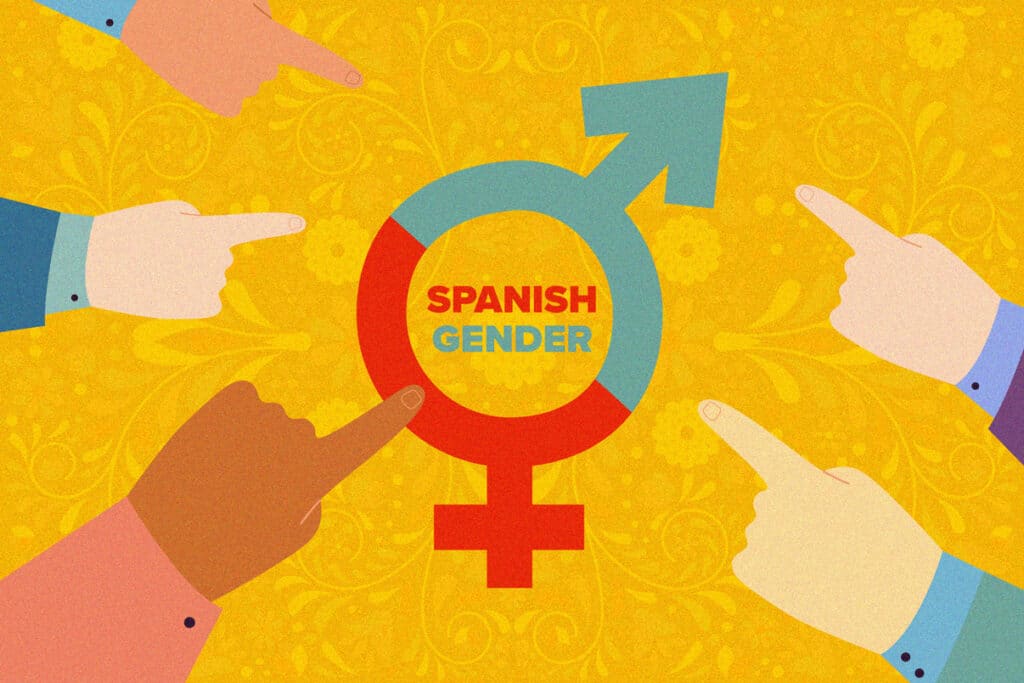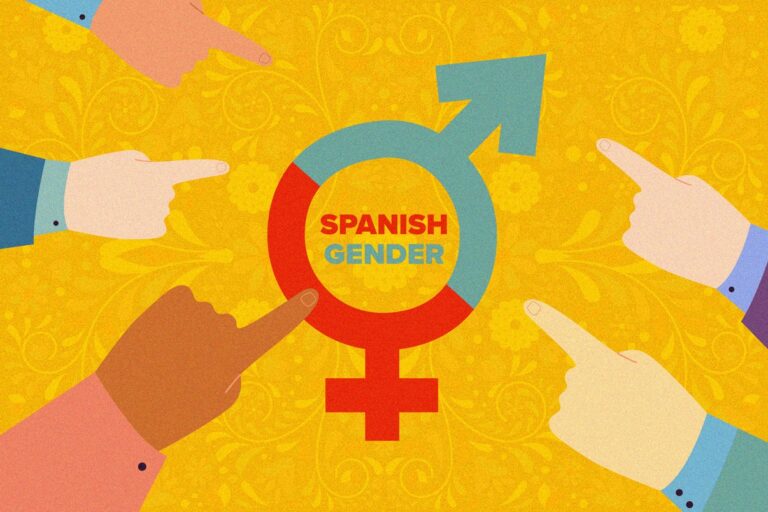
Like many other Romance languages, Spanish nouns all have a género (gender)—either masculine or feminine.
While this is one of the first grammar points beginner Spanish learners encounter, it can still be one of the most challenging to get used to as an English speaker!
In this post, you’ll learn everything you need to know about correctly using gendered nouns in Spanish, plus tips to help you get the hang of them as quickly as possible.
Contents
Download:
This blog post is available as a convenient and portable PDF that you
can take anywhere.
Click here to get a copy. (Download)
What Is Gender in Spanish?
Spanish is a gendered language, which means that all nouns—including inanimate objects—are either masculine or feminine.
Their gender can change other words that follow or precede them, like adjectives.
But while we use gendered pronouns for people (for example él (he) and ella (she)), grammatical gender doesn’t use pronouns. For example, you wouldn’t refer to a table (mesa)—which is feminine—as ella.
Instead, we use gendered articles for this.
Gendered articles in Spanish
As we just mentioned, every noun (a person, place, thing or idea) in Spanish has a specific article that denotes the gender of the word.
There are two types of articles in Spanish: definite and indefinite articles. And both types are gendered.
In English, our definite article is “the” and indefinite articles are words like “a,” “an” and “some.”
There are nine total gendered articles in Spanish:
| Spanish | English | Type of Article |
|---|---|---|
| El | The (masculine) | Definite |
| La | The (feminine) | Definite |
| Los | The (plural, masculine) | Definite |
| Las | The (plural, feminine) | Definite |
| Lo | The (neutral) | Definite (and direct object pronoun) |
| Un | A/an (masculine) | Indefinite |
| Una | A/an (feminine) | Indefinite |
| Unos | Some (masculine) | Indefinite |
| Unas | Some (feminine) | Indefinite |
The singular forms of gendered articles can be used like in these sentences:
La casa es blanca — The house is white
El vestido es azul — The dress is blue
Una mujer habla español — A woman speaks Spanish
Un hombre está en la oficina — A man is in the office
Likewise, we can make these sentences plural by using the corresponding plural forms of the articles:
Las casas son blancas — The houses are white
Los vestidos son azules — The dresses are blue
Unas mujeres hablan español — Some women speak Spanish
Unos hombres están en la oficina — Some men are in the office
Lo is considered a neutral pronoun, but it’s most commonly used as a direct object pronoun—which means it replaces a masculine noun to avoid repetition. For example:
Yo tengo el perro (I have the dog) → Yo lo tengo (I have it)
However, when used as a neutral pronoun, it can be used for arbitrary things or ideas that don’t necessarily have a gender, like this:
Lo que quiero — What I want
Lo que dijiste — What you said
Gendered adjectives in Spanish
You might’ve picked up on this one from the last few examples, but adjectives also have gender in Spanish.
However, they don’t have their own gender like nouns. Instead, they adopt the gender of the nouns they’re describing.
For Spanish sentences to be grammatically correct, everything must match the gender and quantity of the noun—which means adjectives and articles have to become either plural, singular, masculine or feminine depending on the noun.
Take a look at a few more examples and see how the adjectives and pluralization change:
La chica es bonita — The girl is pretty
El perro es viejo — The dog is old
Las flores son rojas — The flowers are red
Los brazos son largos — The arms are long
Rules for Noun Genders in Spanish
1. Nouns that end in “o” are masculine
When talking about living creatures, nouns that end in “o” are masculine.
Examples:
El gato — the male cat
El chico — the boy
El abuelo — the grandfather
2. Nouns that end in “a” are feminine
Similarly, when talking about living creatures, nouns that end in “a” are feminine.
Examples:
La gata — the female cat
La chica — the girl
La abuela — the grandmother
3. Some male-associated nouns are feminine and vice versa
Not everything associated with a male will automatically be masculine, nor everything associated with a female will automatically be feminine—only distinct living creatures fall under this categorization.
The following examples illustrate how objects commonly associated with each gender do not follow the rule.
La corbata — the necktie
El maquillaje — the makeup
El vestido — the dress
Of course, there are thousands of nouns out, which can make memorizing their genders seem impossible.
But the good news is, native speakers will still understand you if you get the gender wrong.
The more you interact with Spanish—whether through conversations with native speakers or by consuming Spanish content—the more you’ll learn to associate nouns with their correct genders.
You could also use an online immersion program. FluentU, for example, has interactive subtitles on all of its videos, making it easier to learn which gender to use in context.
By clicking on any word, you can see a breakdown of its grammar, definition, example sentences and other videos where you can hear the word used with the same meaning.

4. Groups are always referred to as masculine
When there’s a group of mixed gender, no matter what the ratio of females-to-males and males-to-females is, the group is always referred to as masculine.
For example:
1 niño + 4 niñas = 5 niños (1 boy + 4 girls = 5 kids)
3 gatos + 542 gatas = 545 gatos (3 male cats + 542 female cats = 545 cats)
5. Nouns that end in consonants have masculine and feminine versions
Masculine nouns that end in consonants (non-vowels) have a corresponding feminine form that ends in a.
Examples:
El profesor — the male professor
La profesora — the female professor
El doctor — the male doctor
La doctora — the female doctor
El señor — the Mr.
La señora — the Mrs.
6. Some nouns are both masculine and feminine despite their ending
Some nouns that refer to professions do not change their forms—like el taxista/la taxista (the taxi driver).
This does not mean that the importance of gender disappears. If the word does not change, the article is what tells you the gender.
Examples:
El piloto — the male pilot
La piloto — the female pilot
El soldado — the male soldier
La soldado — the female soldier
El modelo — the male model
La modelo — the female model
El atleta — the male athlete
La atleta — the female athlete
El psiquiatra — the male psychiatrist
La psiquiatra — the female psychiatrist
Optional brain exercise: Make a list of nouns that currently surround you (wherever you are) in English (you decide on how many you want to attempt). Try to guess their gender in Spanish. Look up the words and see how many you got right and what rules you recognize.
7. Nouns with specific endings are always feminine
Nouns that end in –sión, –ción, –dad, –tud and –umbre will always require the feminine article.
Examples:
La prisión — the prison
La habitación — the room
La felicidad — the happiness
La solicitud — the application
8. Nouns that end in -ama/-ema are usually masculine
Nouns that end in –ama or -ema pretty much always require a masculine article.
Examples:
El programa — the program
El diagrama — the diagram
El problema — the problem
El emblema — the emblem
9. Some nouns break the “o” and “a” gender rules
Languages exist within a strict framework of rules, yet they are alive, dynamic, and continuously evolving. Therefore, there are always exceptions to the rules, and these exceptions, in turn, create new rules.
Some nouns that end in “a” are masculine, and some nouns that end in “o” are feminine.
Examples:
El día — the day
El mapa — the map
El cura — the priest
El planeta — the planet
La foto — the photo
La mano — the hand
La radio — the radio
La moto — the motorcycle
And there you have it—nine Spanish gender rules and how to use them in Spanish sentences.
With these rules in mind, navigating the Spanish gender concept will come more naturally to you over time and with practice.
Good luck!
Download:
This blog post is available as a convenient and portable PDF that you
can take anywhere.
Click here to get a copy. (Download)



